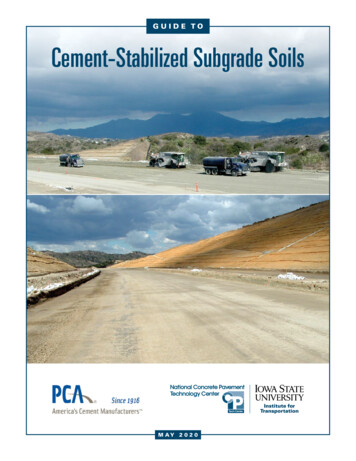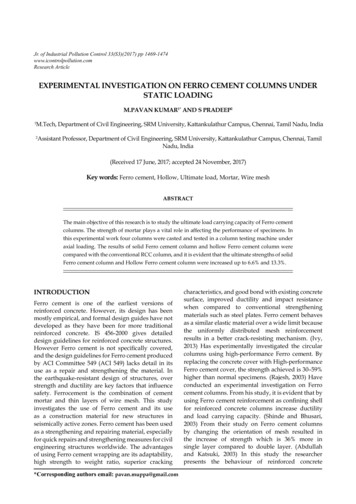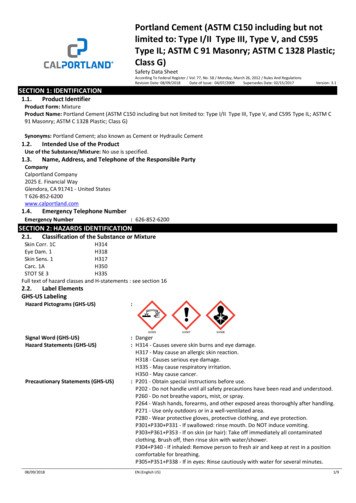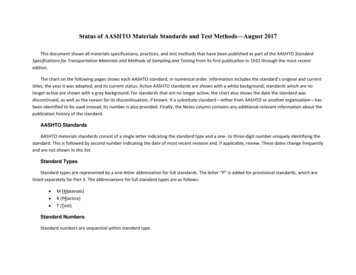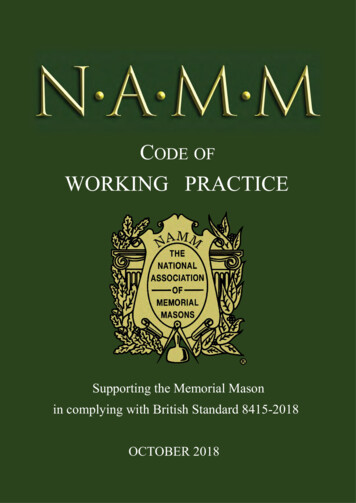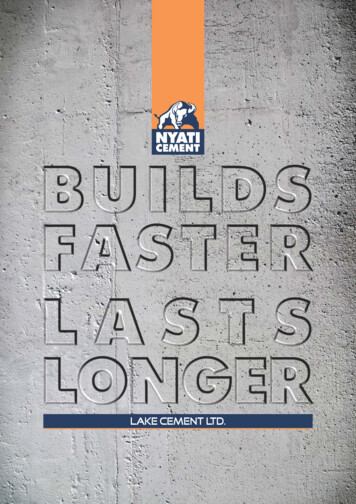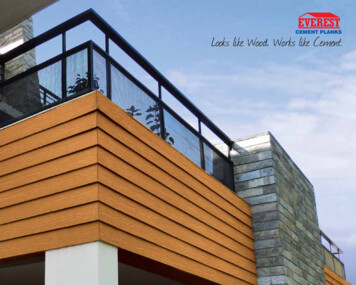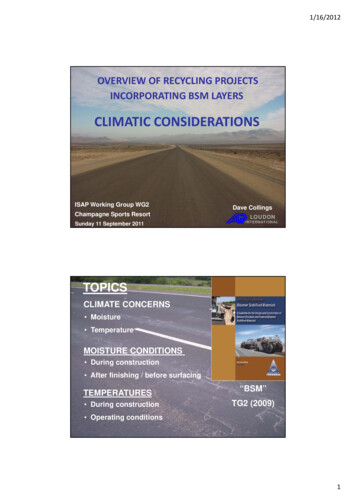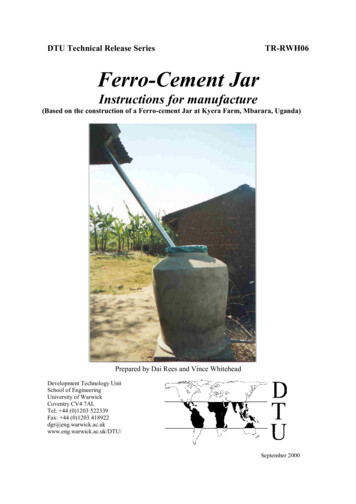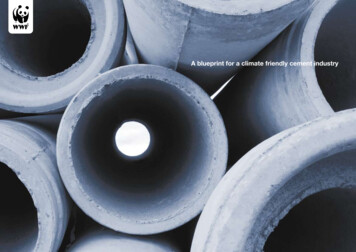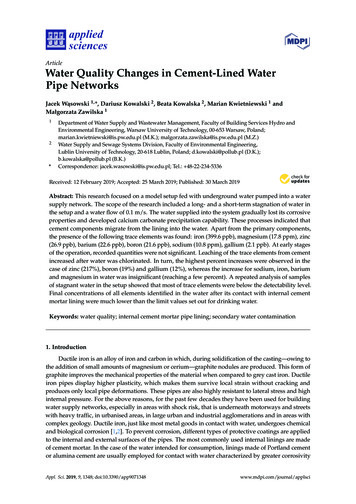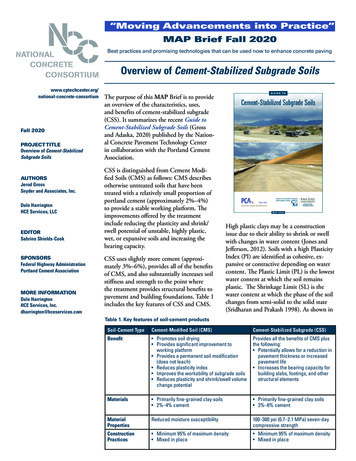
Transcription
“Moving Advancements into Practice”MAP Brief Fall 2020Best practices and promising technologies that can be used now to enhance concrete pavingOverview of Cement-Stabilized Subgrade tiumFall 2020PROJECT TITLEOverview of Cement-StabilizedSubgrade SoilsAUTHORSJerod GrossSnyder and Associates, Inc.Dale HarringtonHCE Services, LLCEDITORSabrina Shields-CookSPONSORSFederal Highway AdministrationPortland Cement AssociationMORE INFORMATIONDale HarringtonHCE Services, Inc.dharrington@hceservices.comThe purpose of this MAP Brief is to providean overview of the characteristics, uses,and benefits of cement-stabilized subgrade(CSS). It summarizes the recent Guide toCement-Stabilized Subgrade Soils (Grossand Adaska, 2020) published by the National Concrete Pavement Technology Centerin collaboration with the Portland CementAssociation.CSS is distinguished from Cement Modified Soils (CMS) as follows: CMS describesotherwise untreated soils that have beentreated with a relatively small proportion ofportland cement (approximately 2%–4%)to provide a stable working platform. Theimprovements offered by the treatmentinclude reducing the plasticity and shrink/swell potential of unstable, highly plastic,wet, or expansive soils and increasing thebearing capacity.CSS uses slightly more cement (approximately 3%–6%), provides all of the benefitsof CMS, and also substantially increases soilstiffness and strength to the point wherethe treatment provides structural benefits topavement and building foundations. Table 1includes the key features of CSS and CMS.High plastic clays may be a constructionissue due to their ability to shrink or swellwith changes in water content (Jones andJefferson, 2012). Soils with a high PlasticityIndex (PI) are identified as cohesive, expansive or contractive depending on watercontent. The Plastic Limit (PL) is the lowestwater content at which the soil remainsplastic. The Shrinkage Limit (SL) is thewater content at which the phase of the soilchanges from semi-solid to the solid state(Sridharan and Prakash 1998). As shown inTable 1. Key features of soil-cement productsSoil-Cement TypeCement-Modified Soil (CMS)Cement-Stabilized Subgrade (CSS)Benefit Promotes soil drying Provides significant improvement toworking platform Provides a permanent soil modification(does not leach) Reduces plasticity index Improves the workability of subgrade soils Reduces plasticity and shrink/swell volumechange potentialProvides all the benefits of CMS plusthe following: Potentially allows for a reduction inpavement thickness or increasedpavement life Increases the bearing capacity forbuilding slabs, footings, and otherstructural elementsMaterials Primarily fine-grained clay soils 2%–4% cement Primarily fine-grained clay soils 3%–6% cementMaterialPropertiesReduced moisture susceptibility100–300 psi (0.7–2.1 MPa) seven-daycompressive strengthConstructionPractices Minimum 95% of maximum density Mixed in place Minimum 95% of maximum density Mixed in place
NC2 MAP Brief Fall 2020Figure 1, the SL increased with the addition of cement. Theend result is when the SL increases, any additional decrease inmoisture below this shrinkage limit will not result in additionalshrinkage. Likewise, as the SL increases, the soil can absorb ahigher percent of moisture (as a result of the increase) beforeany potential swelling.Modification MechanismsCSS physically and/or chemically modifies the makeup of existing subgrade soils that may be unsuitable due to high shrinkage or expansion potential, low bearing capacity, evidence ofinstability, or high moisture contents that will cause unstablesubgrades during construction activity. Refer to Chapter 1 ofthe Guide to Cement-Stabilized Subgrade Soils for a detailedexplanation of modification mechanisms.(2a) Cation ExchangeThe improved engineering properties that CSS imparts to thesubgrade soil, including improved workability, lower plasticity, reduced volume change potential, and increased bearingstrength, are achieved primarily through four modificationmechanisms of cement stabilization illustrated in Figure 2.In order to reduce the plasticity of a soil, the monovalentcations present in a clay surface must be exchanged so thatthe thickness between the clay particles is reduced. Cementcan provide sufficient calcium ions to replace the monovalentcations on the surfaces of the clay particles. This ion exchangeprocess occurs within hours, shrinking the layer of water between the clay particles and reducing the plasticity of the soil/aggregate (Figure 2a).(2b) Particle RestructuringThe addition of cement results in restructuring of modifiedsoil/aggregate particles, known as flocculation and agglomeration, which changes the texture of the material from a plastic,fine-grained material to one resembling a friable, granular soil/aggregate (Halsted et al. 2008).Prior to cement treatment, clay particles are naturally alignedparallel to each other in layers due to their chemical composition. The addition of cement results in restructuring of modi-(2c) Cementitious Hydration(2d) Pozzolanic Reactions2Figure 1. Effect of cement treatment on Atterberg limitsFigure 2. Modification Mechanisms (Halsted et al. 2008 2008PCA, used with permission)
NC2 MAP Brief Fall 2020fied soil/aggregate particles, known as flocculation and agglomeration. Here, the clay particles are aligned randomly in anedge-to-face orientation and changes the texture from a plastic,fine-grained material to a granular-like texture (Figure 2b).Cementitious hydration produces calcium-silicate-hydrate(CSH) and calcium-aluminate-hydrate (CAH) that acts as the“glue” to provide structure in a cement-modified soil/aggregate. The majority of this reaction occurs within the first 30days after cement is added to the soil (Figure 2c).In addition to CSH and CAH, hydrated portland cementalso forms calcium hydroxide, which enters into a pozzolanicreaction. This secondary soil modification process takes thecalcium ions supplied by the incorporation of portland cementand combines them with the silica and alumina dissolved fromthe clay structure to form additional CSH and CAH. (Halstedet al., 2008). Although pozzolanic reactions occur to a muchlesser degree than cementitious hydration, they add furtherstrength and durability to the soil and can continue for severalmonths or years (Figure 2d).CSS Mixture Design1. Determine in situ moisture content and classify soil. Thenative soil’s Atterberg limits, soil classification, gradation,and standard proctor must be determined as they areneeded to move forward with the next step.2. Determine cement type and estimated dosage rate. Typically, locally available cement is utilized along with a starting range of 3%–6%.3. Determine chemical compatibility. If required, thechemical compatibility between the soil and cement canbe investigated. Standard testing, including expansion,stability sulfate content, and pH and organic content canbe performed.4. Determine Atterberg limits of the three different cementcontent treated samples.5. Determine optimum moisture content and maximum drydensity (using cement content from Atterberg limits testing) (see Figure 3).6. Determine the unconfirmed compressive strength at threedifferent cement contents (see Figure 4).7. Plot unconfined compressive strength to verify selecteddesign cement content.8. Compile CSS mixture design report.The CSS mix design process is straight forward. The engineering properties needed are commonly determined with a geotechnical investigation of the native soil along with laboratorytesting using cement. In developing a mix design for CSS, thefollowing laboratory tests are needed: Gradation and Atterberg limits of the untreated soilAtterberg limits of the CSSStandard Proctor compactionUnconfined compressive strengthUnconfined compressive dry strength and wet strength (after10-day free swell)Design ProcessFigure 3. Moisture-density relationship graphDepending on the urgency of the situation, two differentpathways can be taken to incorporate CSS into a project.When marginal conditions are foreseen, that is, before construction begins and sufficient time is available for adequatefield sampling and laboratory testing, the CSS application isconsidered to be on the design path. When unforeseen marginal conditions are encountered during construction (suchas excessively wet and/or unstable soils) and an immediatesolution is required, cement-based mitigation can be expeditedwith engineering judgement, previous experience, and/or anabbreviated laboratory testing program.Step-by-Step CSS Mixture DesignFollowing are the typical CSS mixture design steps for thedesign path:Figure 4. Example of unconfirmed compressive strength versuscement content3
NC2 MAP Brief Fall 2020Construction ProcessThe construction process begins with removal of the existing surface material, which may include vegetation, existingpavement, granular base material, or any other undesirablematerial identified in the geotechnical report. Based on thesoil conditions at the time of construction, the percentageof cement to be added may also be adjusted at this point, ifnecessary.Following are the seven steps that are typical of the construction process (in some instances, initial moisture conditioning and initial pulverization may be necessary based on soilconditions at the time of construction):1.2.3.4.5.6.7.Preliminary gradingCement applicationMixingAchievement of optimum moisture contentCompactionFinal gradingCuringCement ApplicationCement is most commonly applied in a dry condition, whichmay produce an issue with dust. It is important to avoidthe dry application of cement on windy days. Equipment isavailable that minimizes the spread of dust in a uniform andcontrolled application (Figure 5). Cement can also be appliedin slurry form from a distributor truck equipped with anagitation system (Figure 6) or additives designed to keep thesolids in suspension.Most specifications call for the application of cement in termsof weight per area (e.g., pounds of cement per square yardor kilograms of cement per square meter). The percentage ofcement needed is based on the in-place dry unit weight of thenative soil, the application rate specified, and the depth ofsoil treatment. Equations 1 and 2 show how these three variables are used to determine the cement spread rate. Equation1 uses US customary units and Equation 2 uses metric units.(1)(2)Table 2 shows typical spread rates in U.S. customary unitsand metric units, respectively, based on cement percentage,depth of stabilization, and unit weight of soil.MixingOnce cement is spread over the surface of the subgrade, thenext step is to mix the cement into the subgrade materialusing a reclaimer (Figure 7). Mixing should begin within 30minutes of cement placement. It is important to sufficientlypulverize the soil to the full depth and width of mixing,especially for cohesive soils such as silty clays and clays. In thefinal mixture, 100% of the material should pass the 1 1/2 in.(38 mm) sieve and at least 60% should pass the No. 4 (4.75mm) sieve.Figure 5. Spreader truck during portland cement application( 2020 Pavement Recycling Systems, Inc., used with permission)4Figure 6. Spreading portland cement slurry (Halsted et al. 2008, 2008 PCA, used with permission)Figure 7. Mixing portland cement and native soil with areclaimer (Jeff Wykoff, California Nevada Cement Association,used with permission)
NC2 MAP Brief Fall 2020Table 2. Typical cement spread rates (adapted from Halsted et al. 2008)The more finely the soils are pulverized, the more effectivethe cement stabilization treatment will be. Agricultural disks,graders, rippers, and other scarifying equipment are not recommended, especially for cohesive soils, because they cannotachieve the proper degree of pulverization. In contrast, areclaimer uses a mixing drum, operating in an upward cutting direction, to finely mix the cement, existing subgradematerial, and additional water (if required).The proper depth of mixing is a function of design, siteconditions, and available equipment. Reclaimers now havethe capability of uniformly mixing to a depth of up to 24in. (0.6 m). However, if greater depths are required, thesubgrade can be treated with CSS in multiple layers startingat the bottom layer first. Treating in multiple layers is morecostly than single-layer treatment due to the additional effortrequired. One option that may be considered where deeptreatment is necessary would be to add a cement-treated base(CTB) layer on top of a single deep CSS layer.It is very important that the moisture content of the subgrade, particularly in expansive material, be maintained inaccordance with the recommendations in the geotechnicalreport until the material has been covered with base materialor pavement.CompactionOnce the water, cement, and existing subgrade materialshave been mixed, compaction is the next step. The time limitbetween mixing and compacting is not as stringent for CSSas it is for CTB, although when possible compaction shouldoccur immediately after mixing and all CSS constructionoperations should be completed on the same day (Halstedet al. 2008). Each compacted lift should meet the densityrequirements and optimum moisture content requirementsin the geotechnical report or applicable specifications.For applications involving silty and clayey soils, initialcompaction should be done with a vibratory tamping roller(Figure 9) or padfoot roller that compacts from the bottomto the top of the subgrade. Compaction with this type ofroller should continue until the required minimum densityis achieved, which is usually indicated by the padfoot/tamping/sheepsfoot roller “walking out” of the impressions itleaves in the soil.For compaction of sandy or gravelly material and for finalcompaction of silty and clayey soils, a vibratory smoothdrum (Figure 10) or pneumatic tire roller is used.Water is added by injecting the proper amount of moistureinto the mixing chamber of the reclaimer (Figure 8) or byplacing water on the ground with a water truck in a separateoperation. In either case, obtaining the correct amount ofmoisture is very important for achieving the target compaction, particularly in expansive clayey soil.Figure 8. Roadway reclaimer (Snyder & Associates, Inc./NationalCP Tech Center, used with permission)Figure 9. Vibratory sheepsfoot tamping roller ( 2020 PavementRecycling Systems, Inc., used with permission)5
NC2 MAP Brief Fall 2020DiscussionCalifornia SR-241 is a toll road that experiences high volumes of traffic and has a traffic index (TI) of 11. Los PatronesParkway is a 5.5 mile (8.8 kilometer) non-toll extensionof SR-241 with two lanes in each direction. The 2 millionft2 (186,000 m2) of CSS and pavement extend from OsoParkway to Cow Camp Road. From top to bottom, the pavement consists of 2.4 inches (60 mm) of hot-mix asphalt, 7.2inches (180 mm) of warm-mix asphalt, 6 inches (150 mm) ofaggregate base, and 11.4 inches (290 mm) of CSS. Comparedto the initial full-depth asphalt design, the cost savings fromusing CSS were estimated to be between 30% and 40%.Figure 10. Smooth drum roller ( 2020 Pavement RecyclingSystems, Inc., used with permission)For both silty/clayey and sandy/gravelly subgrades, the CSSmaterial should be uniformly compacted to a minimum of95% of maximum dry density. As a final check, a proof rollby a tandem-axle truck loaded to the legal maximum weightmay be performed to ensure an adequate and uniform CSStreatment.To achieve 300 psi (2.1 MPa) at seven days, a cement content of 4% was applied and mixed with the existing subgradeusing two Wirtgen reclaimers (Figure 10). Type II/V cementwas utilized.This project received the 2018 American Society of CivilEngineers (ASCE) Orange County Branch Project of the YearAward in the Outstanding Transportation Project category.Final GradingAfter compaction with the smooth drum roller, final gradingshould be performed using a motor grader or similar equipment. The completed subgrade should be slightly overbuiltand trimmed to avoid the need for thin fills to achieve thefinal crown and grade.CuringAlthough not always done in practice, curing with a fog water spray or bituminous emulsion is suggested to obtain themaximum benefit from the cement treatment. Refer to theguide specifications in Appendix A of the Guide to CementStabilized Subgrade Soils (CSS) for additional informationabout finishing and curing.Figure 11. Reclaimers mixing the subgrade and cement (JeffWykoff, California Nevada Cement Association, used withpermission)Case Study 1: Los Patrones ParkwayProject Information6Year Constructed2018Case TypeDesignFacility LocationLos Patrones ParkwayRancho Mission ViejoSouth Orange County, CaliforniaExisting SoilConditionsWeak and unstable, R-value of 20 (SC)Public AgencyOrange County Public WorksSanta Ana, CaliforniaFigure 12. Compacted subgrade ((Jeff Wykoff, California NevadaCement Association, used with permission)
NC2 MAP Brief Fall 2020Case Study 2: Wilson Middle Schooland Central Elementary SchoolProject InformationYear Constructed2018Case TypeDesignFacility LocationWilson Middle School and Central Elementary SchoolSan Diego, CaliforniaExisting SoilConditionsSandy fat clayDiscussionIn 2018, the Wilson Middle School was demolished and theWilson Middle School and Central Elementary School wasconstructed in its place. Construction also included severaladditional buildings, a parking structure, hardscapes, playground areas, and a drop-off area.Figure 13. Mixing cement and subgrade ( 2020 Pavement Recycling Systems, Inc., used with permission)Geotechnical exploration discovered that the site consisted ofa substantial amount of expansive soil. The plasticity indexof the existing soil ranged from 10 to 36 while the expansionindex ranged from 18 to 155, neither of which is ideal forconstruction.Two options were considered to improve the site’s soil. Thefirst option was to completely remove a portion of the expansive clay soil and replace it with select granular material. Thesecond option was to stabilize the expansive clay soil witheither cement or lime. Cement stabilization proved to be themost viable option for remedying the expansive soil due to itssustainability, its lower cost versus removal and replacement,and the overall time savings that the option would provide.The decision to use CSS eliminated over 3,000 truckloads ofsoil compared to removal and replacement grading operations.Figure 14. Constructing foundation for the school structure( 2020 Pavement Recycling Systems, Inc., used withpermission)A geotechnical evaluation determined that an applicationrate of 5% cement by dry weight of soil would significantlyreduce the plasticity index and the expansion index, allowing the soil to meet the low expansion criterion. The cementwas mixed into the soil using a reclaimer (Figure 13), and thesubgrade was compacted and trimmed, allowing foundationconstruction to be completed (Figures 14 and 15).ReferencesGross, J. and Adaska, W. 2020. “Guide to Cement-StabilizedSubgrade Soils.” Portland Cement Association, Skokie, IL,and National Concrete Pavement Technology Center, IowaState University, Ames, IA. ide to CSS.pdf.Figure 15. Completed foundation on cement-treated subgrade( 2020 Pavement Recycling Systems, Inc., used with permission)7
NC2 MAP Brief Fall 2020Halsted, G.E., W. S. Adaska, and W. T. McConnell. 2008.Guide to Cement-Modified Soil (CMS). Portland CementAssociation, Skokie, IL. 42.pdf.Jones, L.D. and Jefferson, I. 2012. Expansive Soils. In: Burland, J., Chapman, T., Skinner, H., Brown, M. (Eds.), ICEManual of Geotechnical Engineering. Volume 1: Geotechnical Engineering Principles, Problematic Soils and Site Investigation. ICE Publishing, London, 413-441.PCA. 2001. Soil-Cement Inspector’s Manual. 2nd edition.Portland Cement Association, Skokie, IL. ving-pdfs/soil cement/pa050-03 reduced-size.pdf?sfvrsn 2.Prusinski, J. R. and S. Bhattacharja. 1999. Effectiveness ofPortland Cement and Lime in Stabilizing Clay Soils. Transportation Research Record: Journal of the TransportationResearch Board, No. 1652, pp. 215–227. 28.Scullion, Tom, Sebesta, Stephen, Harris, John P., Syed, Imran. 2005. Evaluating the Performance of Soil-Cement andCement Modified Soil for Pavements: A Laboratory Investigation. Portland Cement Association, Skokie, IL.
The Shrinkage Limit (SL) is the water content at which the phase of the soil . al Concrete Pavement Technology Center in collaboration with the Portland Cement Association. CSS is distinguished from Cement Modi- . Most specifications call for the application of cement in terms of weight per area (e.g., pounds of cement per square yard .
